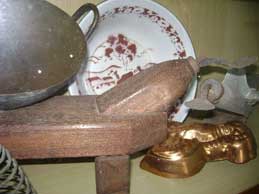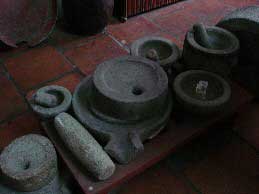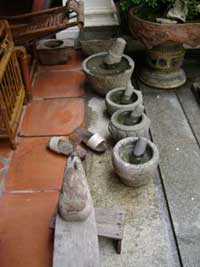 |
||
|
Follow @Nazlina
Methods of Grinding SpicesMethods of grinding spices evolve over the years. Long time ago, when human beings started processing their food, they discovered that some plants could be stored longer and also tasted nicer if they were pounded with stones or ground finely.
For example, seeds or grains of rye or wheat. As for spices, for easy of transport, or as the recipe calls it, they should normally be ground. Methods for grinding spices for modern households normally include electric pepper grinder (for dry spices - like black pepper and cinnamon) or electric blender (for wet spices - like onion, ginger and chili paste).
When I was a child, it always fascinated me to watch a particular Indian lady at the wet market. A wet market is the open air place where fresh fruits, vegetables, fish and meat were sold at a cheaper price compared to the supermarket. (View the description of my market tour here). She would be sitting in front of an array of readily ground wet spices. They were of different colors. Red for chili, orange for turmeric, gray for coriander, white for garlic, brown for aniseed. So what people would do then was to tell the lady what kind of dishes they were going to prepare with their meat or chicken or fish. She would deftly pinched a little of this and a little of that and wrapped the mound of the paste in a piece of banana leaf. So, there was no guesswork on what to add in the curries or how much because the "prescribed" paste already took into account how many kilos of fish or how many chickens were going to be used for each batch. In the old days methods of grinding spices are different. Before electric blenders, the spices were painstakingly ground manually.
Every house had their own pestle and mortar made of undressed granite. This was used for grinding small quantities of spices. For bigger amount, they used "batu giling" - something similar to a fat rolling pin made of raw granite and rolled over a thick flat granite slab (think how much workout you get from daily usage of that!).
Sometimes a family hire a woman (usually an Indian lady) who goes from house to house to grind the spices manually, enough supply for a week. It is a dying practice even though I know some ladies would refuse to cook if they were forced to use pre-ground dry spices in the packets that we are so used to nowadays. Batu kisar - a mini version of a stone mill was also used. However, this was mainly used for turning rice grain into rice powder. These are considered primitive tools because they have been used since the Stone Age! Needless to say, it is very rare nowadays to see such a spectacle. Recently, I had a good opportunity to visit the Cheah Kongsi in Penang, Malaysia. It is a small complex consisting of living areas, classrooms, with servant quarters, a rock garden as well as a temple. For the Cheah clan, this place is a legacy of their founding fathers who came all the way from China to set up business and finally settling in Penang back in the 19th century.
As a group that represents some of the Nyonya culture, it was interesting to observe their ancient kitchen. Left just the way it used to be. Complete with giant manual grinding machine, mortars and also granite slabs. The methods of grinding spices involving these tools are hardly used now. For your information, the Cheah Kongsi is one of the most visited places out of Penang Heritage Trail. I could see brass molds for making kuih kapit, putu kacang, baulu, kukur nyior (manual coconut grater) and the like in the kitchen. It was such a pleasure to see all these antiques cooking utensils! Now, back to our topic above. Powdered spices are normally readily packed in plastic packets. So, we need only to choose the brands we are partial to. However, old people still swear by traditional methods. It is said spices ground manually taste so much better than those processed by electricity. They also say, after using the mortar, rinse once and do not throw away the water used, instead throw it in the pot for a tastier meal!
However, these methods of grinding spices have been adapted that they are similar to the principle of an electric sewing machine. An electric motor is added. Instead of using manual labor, time and cost saving methods are employed instead. In my house, I have the top of the line food processor and an electric blender. However, nowadays I find it more easy to use my faithful pestle and mortar to grind my spices as my preferred methods of grinding spices. The action of pounding the stones and making a lot of noise is therapeutic! It is like blending with nature and going back to the stone age. Over the lifetime of a cook, she is quite likely to wear out several sets of pestle and mortar. The reason is because, when the set has become smooth with wear, it is no longer good for breaking up the peppercorns, for example. So a new set is required. Somehow, a worn set, dark with age for frequent washing and stained with the color of spices can become the pieces that hold sentimental value. Am I getting old or what? *grin* Back to the top of Methods of Grinding Spices Back to the homepage of Pickles and Spices

Custom Search
|

Custom Search
Nazlina's Cooking Class in PenangAttend my cooking class to learn making traditional food.
The morning class includes Penang Market Tour.
PLEASE NOTE: We now offer PM classes, for vegan and vegetarians. What is the difference between herbs and spices? Find out here. Learn to make biryani step by step with photos. It is a good practise for you to learn about these spices. More tips for storing spices here. |
|
|
|
||
|
|
||







 Back
to the old mill story. If you
look at Alagappa's brand logo, you will see the picture of a manual mechanical
mill. I have actually seen one of those in a curry powder shop.
Back
to the old mill story. If you
look at Alagappa's brand logo, you will see the picture of a manual mechanical
mill. I have actually seen one of those in a curry powder shop.


New! Comments
Have your say about what you just read! Leave me a comment in the box below.